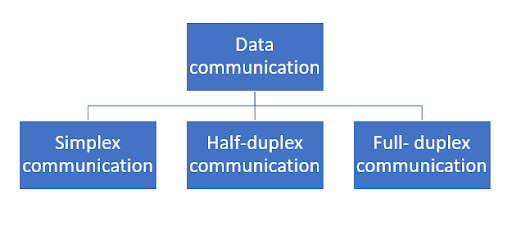
What is data communication and its types?
Answer
180k+ views
Hint: Data Communication is made up of two words: data and communication. Text, image, audio, video, and multimedia files. The act of sending or receiving information is known as communication.
Complete step by step solution:
Digital communication is the exchange of data between a source and a receiver across a transmission medium such as a wire cable. Data communication is the process of sending and receiving data from one device to another. There are three types of data communication:

Image: Types of communication
1. Simplex Communication: It is one-way communication, or unidirectional communication, in which one device only receives data and another device only transmits data, and both devices use their whole transmission capacity. For instance, in the Internet of Things, data entry with a keyboard
2. Half-duplex communication: It is two-way or bidirectional communication in which both devices can send and receive data but not at the same time. When one device sends data, the other just receives data and vice versa. For instance, a walkie-talkie.
3. Full-duplex communication: It is two-way or bidirectional communication in which both devices can send and receive data at the same time. For instance, Mobile phones
Note: The transport of data between two sites is the focus of data communication networks. Data starts from the source and ends up at the sink, which is also known as the destination. It can also be categorized based on the medium through which the signal travels.
Complete step by step solution:
Digital communication is the exchange of data between a source and a receiver across a transmission medium such as a wire cable. Data communication is the process of sending and receiving data from one device to another. There are three types of data communication:

Image: Types of communication
1. Simplex Communication: It is one-way communication, or unidirectional communication, in which one device only receives data and another device only transmits data, and both devices use their whole transmission capacity. For instance, in the Internet of Things, data entry with a keyboard
2. Half-duplex communication: It is two-way or bidirectional communication in which both devices can send and receive data but not at the same time. When one device sends data, the other just receives data and vice versa. For instance, a walkie-talkie.
3. Full-duplex communication: It is two-way or bidirectional communication in which both devices can send and receive data at the same time. For instance, Mobile phones
Note: The transport of data between two sites is the focus of data communication networks. Data starts from the source and ends up at the sink, which is also known as the destination. It can also be categorized based on the medium through which the signal travels.
Recently Updated Pages
Uniform Acceleration - Definition, Equation, Examples, and FAQs

Difference Between Mass and Weight

JEE Main 2023 April 13 Shift 2 Question Paper with Answer Key

JEE Main 2023 April 11 Shift 2 Question Paper with Answer Key

JEE Main 2023 April 10 Shift 2 Question Paper with Answer Key

JEE Main 2023 (April 8th Shift 2) Physics Question Paper with Answer Key

Trending doubts
JEE Main 2025 Session 2: Application Form (Out), Exam Dates (Released), Eligibility, & More

JEE Main 2025: Derivation of Equation of Trajectory in Physics

Displacement-Time Graph and Velocity-Time Graph for JEE

Electric field due to uniformly charged sphere class 12 physics JEE_Main

Atomic Structure - Electrons, Protons, Neutrons and Atomic Models

Wheatstone Bridge for JEE Main Physics 2025

Other Pages
JEE Advanced Marks vs Ranks 2025: Understanding Category-wise Qualifying Marks and Previous Year Cut-offs

Learn About Angle Of Deviation In Prism: JEE Main Physics 2025

What is Hybridisation in Chemistry?

JEE Main 2025: Conversion of Galvanometer Into Ammeter And Voltmeter in Physics

JEE Advanced Weightage 2025 Chapter-Wise for Physics, Maths and Chemistry

Electric Field Due to Uniformly Charged Ring for JEE Main 2025 - Formula and Derivation




